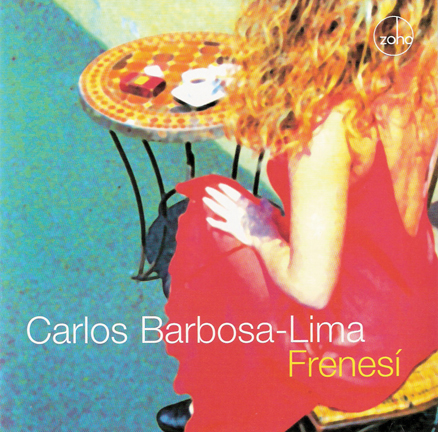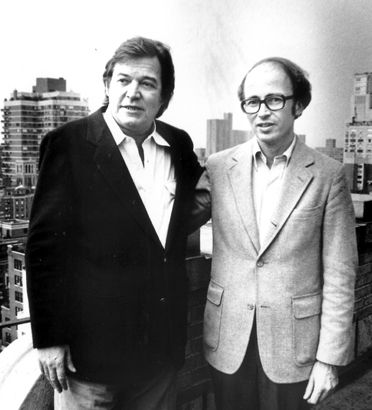|
Carlos Barbosa-Lima
Frenesi
Release Date: August 3, 2004
Selection #: ZM 200408
Songs:
1. Chega de Saudade 3:44
2. Porro 3:30
3. Batucada 2:41
4. Maria Bonita 3:36
5. Frenesi 3:58
6. Natalia 3:33
7. Sigo Pensando En Ti 2:59
8. Danza Caracteristica 2:12
9. El Nino 3:31
10. La Reina 2:53
11. Perfume de Gardenia 3:39
12. Lejos del Hogar 3:39
13. Angostura 2:10
14. Preludio 2:59
15. Adios 4:25
16. Don't Cry for me Argentina 3:43
|
Musicians:
Carlos Barbosa-Lima - guitar
Gustavo Colina - cuatro, on tracks 6, 9, 10, 12, 13, 15
John Benitez - acoustic bass, on tracks 1, 4, 5, 15,
Edgardo Aponte - maracas, bongos, rainstick, cow bells, on tracks 1, 2, 5, 15
|
 |
|
One of the most adventurous and versatile acoustic guitarists in the world for over three decades, Carlos Barbosa-Lima is once again “pushing the creative envelope” with Natalia, the present collection of Latin American guitar music in unique, and breathtakingly virtuosic arrangements.- Born in São Paulo, Brazil, Mr. Barbosa-Lima made his concert debuts at age 12 in São Paulo and Rio de Janeiro. At the same time, he recorded his first record Dedos Mágicos (“Magic Fingers”).
Mr. Barbosa-Lima studied with Isaias Savio and the legendary Andrés Segovia. Since his U.S. debut in 1967, he has enjoyed a global concert career marked by numerous distinguished recordings. This new ZOHO CD release is his 26th, with 20th century repertoire from Mexico, Puerto Rico, Cuba, Venezuela, Colombia, Brazil and – the U.K.
Joining Carlos for this recording, Gustavo Colina plays the cuatro, a small four-string guitar popular throughout Venezuela. Other guest artists are John Benitez, the well known Latin jazz bassist, and Edgardo Aponte, a leading percussionist also from Puerto Rico.
Chega de Saudade is a well-known Bossa Nova by Antonio Carlos Jobim (1927-1994), arguably the most important Brazilian songwriter of the 20th century. In an emotional tribute to his friend, Carlos wrote this remarkable new trio arrangement. Following an introspective guitar introduction, he creates an irresistible, tightly interlocking Bossa Nova groove with only the slightest bass and percussion accompaniment.
Frenesí by Alberto Dominguez (1913 - 1975) is one of those familiar standards that transcends its “Latin” category. Carlos’ arrangement starts with a masterful, improvisatory guitar solo which leads into a gently swinging trio section. It is followed by another guitar interlude composed by Hawaiian guitarist Byron Yasui, and an accompanied bass solo, and ends in a trio restatement of the familiar melody.
Porro by Gentil Montaña (b. 1942) is an Afro-Colombian song form hailing from the Pacific coastal region of that country. Porro is the fourth movement of Montaña’s Suite Colombiana No. 2 for guitar, and here has been arranged highly effectively for guitar, cuatro and light percussion: maracas, triangle and palo de lluvia (“rain stick”).
Batucada by the Uruguyan-born Isaias Savio (1900-1977) is a fast, colorful guitar solo that incorporates typical dance rhythms heard in the Afro-Brazilian percussive ensemble of the same name. Savio was Barbosa-Lima’s teacher in Brazil.
María Bonita is a waltz by Mexican composer Agustín Lara (1896-1970), a self-taught pianist whose songs catapulted him to international recognition during the 1940’s. In Barbosa-Lima’s athmospheric guitar and bass duo arrangement, both instruments are exploring the famous theme in inspired, concentrated solos.
The Venezuelan waltz Natalia by Antonio Lauro (1917-1986), is widely performed as a guitar sol. Barbosa-Lima presents it here as a duet of great, sensuous beauty, with Gustavo Colina’s cuatro creating a delightful secondary part.
Sigo Pensando en Ti, a classic ballad that was written by Colombian composer Alvaro Dalmar (1923-1999), and Barbosa-Lima’s richly voiced arrangement for guitar solo perfectly catches the song’s sweetly sentimental character.
Danza Característica by Leo Brouwer (b. 1938) utilizes a well-known Cuban conga rhythm as its structural motif: “quítate de la acera” (“get off the sidewalk”). During days of celebration, people join together with percussion instruments and march down the street, banging out this rhythmic pattern. Thus the name—if you hear them coming, you better remove yourself from the sidewalk!
Antonio Lauro’s waltz El Niño (“the boy”) is dedicated to his son. It is a work of lyric sentiment with intricate counterpoint, rendered here as a memorable duet for guitar and cuatro.
La Reina is a contradanza from Venezuela by the nineteenth century Maracaibo composer Amable Torres (1860-1908) arranged for guitar and cuatro by Colina and Barbosa-Lima. This tuneful work features the instruments alternating solos in a rich contrapuntal texture.
|
 Carlos Barbosa-Lima (right) with Antonio Carlos Jobim. New York City,1985. Carlos Barbosa-Lima (right) with Antonio Carlos Jobim. New York City,1985.
Perfume de Gardenia by the Puerto Rican Rafael Hernandez (1892-1965) expressively portrays the qualities of its title “perfume of a gardenia”. Hernandez was a genius at composing popular melodies, and among his many enduring works figure El Cumbanchero and Lamento Borincano.
Lejos del Hogar is from a suite for guitar by the young Colombian composer Jaime Romero (b. 1966). Romero studied with Gentil Montaña and has composed numerous works for guitar typical of his native Colombia.
Angostura, named after Antonio Lauro’s native city, is one of his most popular Venezuelan waltzes. With its intense pulsating rhythms and plaintive melodic lines for guitar and cuatro, it becomes a virtuosic showcase for the unique talents of Barbosa-Lima and Colina.
Preludio by Leo Brouwer is from his lyrical three-movement “Suite No. 2” that the composer wrote when he was 15! It is an early example of his awesome talent which transformed the world of classic guitar during the latter twentieth century.
Adios was composed by Enrique Madriguera (1904-1973), who achieved great popularity during the 1930’s. Carlos’ trio arrangement features a slow, atmospheric beginning, leading into the main theme with a gently swaying rumba rhythm. There is a delightful guitar interlude followed by a spicy, accompanied bass solo. Finally, percussion returns for the closing theme.
The ever popular, anthemic Don’t Cry for Me Argentina from the musical Evita by Andrew Lloyd Webber (b. 1948) is a frequent, literally show-stopping encore in Barbosa-Lima’s live concerts. Here he demonstrates his masterful skills as an arranger, breathtakingly exploiting all resources of the guitar, including the use of the melodic line played in octave harmonics.
Rico Stover
All arrangements by Carlos Barbosa-Lima. Produced by Heiner Stadler. Recorded, edited and mixed at PRT Studio, Puerto Nuevo, Puerto Rico, in June – August 2002. Engineer: Pedro Toledo Rivera. Mastered at the Carriage House, Stamford, CT by Phil Magnotti. Executive Producer: Joachim Becker.
Carlos Barbosa-Lima plays a guitar by Andres Caruncho, Miami, Florida, built in 1996.
|
|
|
|

